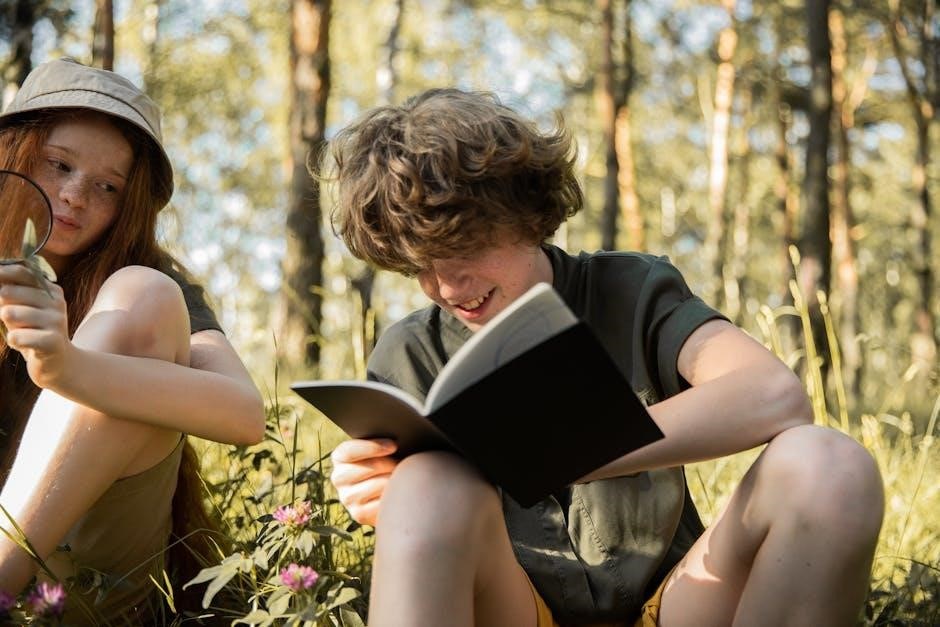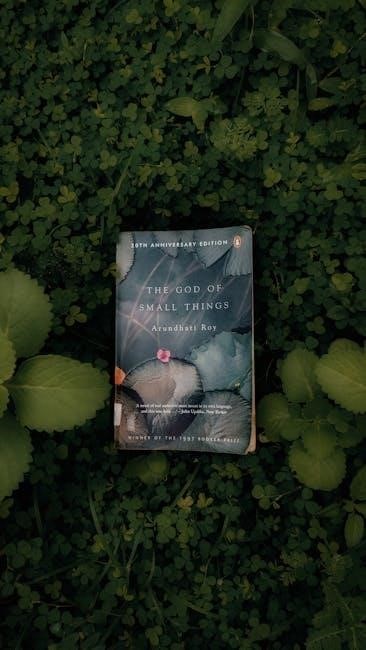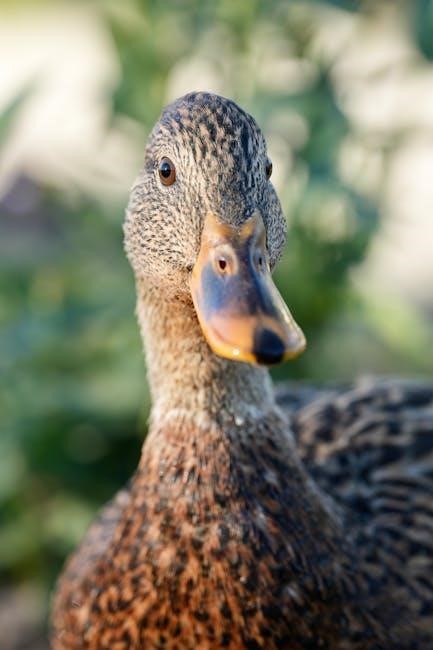
Maurice Sendak’s “Where the Wild Things Are” is a timeless children’s classic, first published in 1963. This beloved story follows Max’s journey to a fantastical land of creatures, exploring themes of adventure and imagination. The book has sold over 19 million copies worldwide, becoming a cornerstone of children’s literature. Its unique illustrations and heartfelt narrative have captivated readers for generations, making it a must-read for both children and adults alike. The PDF version of the book is widely available for digital readers, ensuring its accessibility to new generations.
1.1 Overview of “Where the Wild Things Are”
Maurice Sendak’s Where the Wild Things Are is a captivating children’s book first published in 1963. The story follows Max, a young boy who travels to a fantastical land inhabited by mythical creatures known as the “Wild Things.” Max’s journey explores themes of imagination, adventure, and the complexities of childhood emotions. The book is renowned for its distinctive illustrations and poignant narrative, which have made it a beloved classic worldwide. Its enduring popularity has led to its availability in various formats, including PDF, allowing readers to access and enjoy this timeless tale digitally.
1.2 Importance of the Book in Children’s Literature
Where the Wild Things Are holds a significant place in children’s literature for its innovative storytelling and emotional depth. It revolutionized the genre by addressing complex emotions like anger and loneliness through Max’s journey. The book’s unique blend of text and illustrations created a new standard for visual storytelling. Winning the Caldecott Medal in 1964, it has inspired countless authors and illustrators. Its exploration of imagination and self-discovery continues to resonate with readers, making it a timeless classic that bridges generations and remains a cornerstone of children’s literature.

Background of the Author
Maurice Sendak, born in 1928, was a renowned author and illustrator whose childhood experiences deeply influenced his work. His unique storytelling style, blending imagination and emotion, made him a legend in children’s literature.
2.1 Maurice Sendak: A Brief Biography
Maurice Sendak was a celebrated American author and illustrator, best known for Where the Wild Things Are. Born on June 10, 1928, in Brooklyn, New York, to Jewish immigrant parents, Sendak’s early life was marked by a deep love for storytelling and art. He grew up in a family that valued creativity, which inspired his unique narrative style. Sendak’s career began as an illustrator for children’s books before he transitioned to writing his own stories. His work often explored complex emotions and fantastical worlds, resonating with readers of all ages. Sendak passed away in 2012, leaving behind a legacy as one of the most influential figures in children’s literature.
2.2 Sendak’s Contributions to Children’s Literature
Maurice Sendak revolutionized children’s literature by introducing complex emotions and darker themes, breaking away from traditional sanitized storytelling. His work, including Where the Wild Things Are, explored anger, loneliness, and imagination, resonating deeply with young readers. Sendak’s unique art style and ability to address universal childhood experiences set a new standard for authenticity in children’s books. His contributions have inspired generations of authors and illustrators, solidifying his legacy as a pioneer who transformed the genre into a more emotionally nuanced and artistically expressive field.
Plot Summary
Max’s journey to a fantastical land, becoming king of Wild Things, and returning home explores themes of adventure, imagination, and childhood emotions in a timeless tale.
3.1 Key Events in the Story
Max, dressed in his wolf costume, causes mischief at home, leading to his banishment to his room. A forest grows, and he sails to a land inhabited by Wild Things. Max tames them, becoming their king, and they engage in a wild rumpus. However, Max feels homesick, bids farewell, and returns home to find his supper still hot. These events showcase Max’s journey of independence, leadership, and the comfort of home, forming the core of the narrative.
3.2 Themes of Adventure and Imagination
Max’s journey embodies the themes of adventure and imagination, as he explores a fantastical world where Wild Things roam. His voyage symbolizes the boundless creativity of childhood, where imagination transforms ordinary spaces into extraordinary realms. The story highlights the emotional depth of adventure, blending excitement with the comfort of home. Sendak’s portrayal of Max’s leadership and connection with the Wild Things underscores the power of imagination in navigating challenges and understanding oneself. The book encourages readers to embrace their inner wildness while finding solace in familiar surroundings, making it a timeless tale of adventure and creative exploration.

Themes and Analysis
The book masterfully explores themes of independence, emotional growth, and the complexities of childhood. Max’s journey offers a profound understanding of self-discovery and the comfort of home.
4.1 The Concept of “Wildness” in the Book
The concept of “wildness” in Where the Wild Things Are symbolizes the untamed emotions and instincts of childhood. Max’s journey to the land of the Wild Things represents an exploration of his inner world, where he grapples with anger, rebellion, and the need for control. The Wild Things themselves embody the chaotic yet alluring aspects of being “wild,” while Max’s eventual return home highlights the duality of seeking freedom and longing for security. Sendak uses this theme to illustrate the universal struggle of balancing wildness with the comforts of belonging and the structure of society.
4.2 The Relationship Between Max and the Wild Things
Max’s relationship with the Wild Things evolves from initial fear to mutual respect and understanding. Initially, the creatures are intimidating, but Max tames them with courage and creativity, earning their admiration. As their “king,” Max leads them in playful chaos, forming a bond rooted in shared emotions and a need for connection. However, Max eventually realizes the importance of home and leadership, deciding to leave. This relationship highlights themes of empathy, control, and the complexity of human emotions, showcasing how Max grows through his interactions with the Wild Things.

Reception and Reviews
The book received widespread critical acclaim for its unique storytelling and illustrations, earning the Caldecott Medal. It explores complex themes, sparking both admiration and controversy among parents.
5.1 Critical Acclaim and Awards
Where the Wild Things Are has received widespread critical acclaim since its publication in 1963. The book won the prestigious Caldecott Medal in 1964, recognizing its outstanding illustrations. Critics praised Maurice Sendak’s unique storytelling and the way he balanced fantasy with emotional depth. The book has been named one of the best children’s books of all time by numerous publications, including Time Magazine and School Library Journal. Its exploration of childhood emotions and imagination has solidified its place in literary history, despite initial controversy over its darker themes.
5.2 Public Reaction and Popularity
Where the Wild Things Are quickly captivated readers upon its release, becoming a beloved classic. Despite initial concerns about its darker themes, the book resonated deeply with children and parents alike. Its unique storytelling and universal themes of independence and belonging have made it a staple in many households. The book’s popularity grew steadily, and it has been translated into numerous languages. Fans of all ages have embraced Max’s journey, making it one of the most cherished children’s books of the 20th century. Its enduring appeal continues to inspire new generations of readers.

Cultural Impact
Where the Wild Things Are has left a lasting imprint on children’s literature and popular culture, inspiring countless adaptations, from films to stage productions. Its iconic imagery and themes have influenced artists, writers, and filmmakers, cementing its status as a cultural phenomenon. The book’s exploration of emotions and imagination continues to resonate globally, making it a timeless classic that transcends generations. Its influence is evident in modern storytelling, ensuring its legacy endures.
6.1 Adaptations and Interpretations
Where the Wild Things Are has been adapted into various forms, including a feature film directed by Spike Jonze in 2009, stage plays, and animated series. These adaptations have expanded the story’s reach, introducing it to new audiences while staying true to its essence. The book’s themes of imagination and childhood have inspired countless interpretations in art, music, and even fashion. Its universal appeal has made it a cultural touchstone, allowing it to transcend its original medium and resonate across generations. Each adaptation offers a fresh perspective, further cementing its place in cultural history.
6.2 The Book’s Influence on Popular Culture
Where the Wild Things Are has profoundly influenced popular culture, becoming a cultural icon. Its imagery and themes appear in films, music, and art, with references in works like The Simpsons and Stranger Things. The Wild Things have inspired fashion designs, merchandise, and even tattoos. The book’s quotes, such as “Let the wild rumpus start!” are widely recognized. Its exploration of childhood and imagination resonates across generations, making it a timeless symbol of creativity and self-expression. This enduring impact highlights its significance beyond literature, embedding it deeply in global culture.
Availability of the Book in PDF Format
The book is widely available in PDF format on popular platforms like Google Books and Amazon. Check libraries or eBookstores for free or paid access legally.
7.1 Sources for Downloading the PDF
The PDF version of Where the Wild Things Are can be found on various platforms. Amazon Kindle, Google Play Books, and eBookstores like Barnes & Noble offer it for purchase. Additionally, libraries provide access through services like OverDrive or Libby for borrowing. Some websites may offer free downloads, but be cautious of unauthorized sources to avoid legal issues. Always opt for official retailers or library services to support the author and publisher.
7.2 Legal Considerations for PDF Downloads
Downloading Where the Wild Things Are in PDF format requires adherence to copyright laws. The book is protected under copyright, and unauthorized downloads are illegal. To avoid legal consequences, ensure you obtain the PDF from authorized sources like official bookstores or libraries. Purchasing from platforms such as Amazon, Google Play Books, or your local bookstore supports the author and publisher. Libraries often provide legal access through e-lending services. Always respect intellectual property rights to avoid legal issues and promote fair practices in literature distribution.
Digital Editions and Accessibility
Where the Wild Things Are is available in digital formats, including e-books, accessible via platforms like Kindle and Epic!. Features like text-to-speech and adjustable fonts enhance readability for all readers, ensuring accessibility and convenience.

8.1 E-Book Formats and Platforms
Where the Wild Things Are is available in various e-book formats, including EPUB and PDF, ensuring compatibility with devices like Kindle, tablets, and smartphones. Popular platforms such as Amazon Kindle, Google Play Books, and Apple Books offer the title for easy access. Additionally, platforms like Epic! provide access to the book for educational purposes. These formats allow readers to enjoy the story with features like adjustable fonts and night reading modes, enhancing the digital reading experience while preserving the timeless appeal of Sendak’s work;
8.2 Accessibility Features for Readers with Disabilities
The digital editions of Where the Wild Things Are include accessibility features for readers with disabilities. Many e-book platforms offer screen reader compatibility, allowing visually impaired readers to enjoy the story. Additionally, adjustable font sizes and high-contrast modes cater to those with vision challenges. Some platforms also provide dyslexia-friendly fonts, enhancing readability. These features ensure that Maurice Sendak’s beloved tale remains accessible to all readers, regardless of their abilities, fostering inclusivity in children’s literature and education.

Educational Value
Where the Wild Things Are fosters creativity, emotional intelligence, and social skills in children. Its themes of imagination and resilience make it a valuable educational resource.
9.1 Use in Classrooms and Educational Settings
Where the Wild Things Are is widely used in classrooms to teach emotional intelligence and creativity. Teachers incorporate the book into lesson plans to explore themes like imagination, bravery, and self-control. Reading sessions often lead to discussions about empathy and understanding, helping students develop social skills. The story’s vivid imagery and simple text make it accessible for early readers, while its depth encourages critical thinking in older students. Educators also use the book to teach narrative structure, character development, and the role of illustrations in storytelling. Its versatility makes it a timeless resource for diverse educational goals.
9.2 Psychological Insights for Child Development
Where the Wild Things Are offers profound psychological insights into child development, exploring themes of anger, independence, and the comfort of home. Max’s journey reflects the emotional struggles of childhood, where children often navigate feelings of rebellion and the need for security. The story provides a safe space for children to process complex emotions, fostering empathy and self-awareness. Its depiction of Max’s resilience and growth mirrors developmental stages, helping children understand their own emotional landscapes. The book’s simplicity and depth make it a valuable tool for fostering emotional intelligence in young readers.

Illustrations and Art Style
Maurice Sendak’s illustrations in Where the Wild Things Are are iconic, blending intricate textures and emotional depth. His unique art style captivates readers, enhancing the story’s timeless appeal.
10.1 The Unique Art Style of Maurice Sendak
Maurice Sendak’s illustrations in Where the Wild Things Are are renowned for their intricate pen-and-ink drawings and expressive watercolor textures. His unique art style blends fantasy and realism, creating a timeless visual experience. The Wild Things, with their fearsome yet endearing designs, have become iconic figures in children’s literature. Sendak’s ability to convey emotion through facial expressions and body language adds depth to the story. His artistry not only complements the narrative but also stands independently as a celebration of imagination and creativity, leaving a lasting impact on readers of all ages.
10.2 The Role of Illustrations in Storytelling
The illustrations in Where the Wild Things Are are integral to the storytelling, visually capturing Max’s journey and emotions. Maurice Sendak’s artwork conveys the fantastical elements of the narrative, bringing the Wild Things to life with intricate details. The interplay between text and images allows readers to interpret the story on multiple levels, enhancing the emotional depth. The illustrations also invite readers to explore the imaginative world, making the book a visually immersive experience. This synergy between art and text has made the story timeless, appealing to readers of all ages and backgrounds.

Comparisons with Other Works
Where the Wild Things Are shares themes of adventure and self-discovery with classics like Alice in Wonderland and The Wizard of Oz. However, its unique art style and emotional depth set it apart, making it a standout in children’s literature. The book’s exploration of imagination and childhood emotions resonates similarly to works by Beatrix Potter, yet its boldness and complexity are unparalleled. Sendak’s work has influenced modern authors, inspiring stories that embrace emotional expression and imaginative worlds.
11.1 Similar Themes in Other Children’s Books
Where the Wild Things Are explores themes of imagination, adventure, and emotional growth, similar to works like Alice in Wonderland and The Secret Garden. These stories feature protagonists who navigate fantastical worlds or transformative journeys, mirroring Max’s voyage. However, Sendak’s approach stands out for its raw emotional depth and minimalist narrative. While The Lion, the Witch, and the Wardrobe also delves into imagination and self-discovery, Sendak’s focus on a child’s inner world and his bold, expressive illustrations make Where the Wild Things Are uniquely impactful.
11.2 Comparative Analysis with Modern Children’s Literature
Modern children’s literature often echoes the emotional depth and imaginative storytelling found in Where the Wild Things Are. Books like The Giving Tree by Shel Silverstein and Inside Out & Back Again by Thanhha Lai explore themes of love, loss, and self-discovery, similar to Max’s journey. However, Sendak’s work remains unique in its minimalist yet profound approach. Contemporary authors like Neil Gaiman, in The Graveyard Book, also blend fantasy with emotional realism, a trend that owes much to Sendak’s pioneering style. His influence is evident in the way modern stories balance imagination with raw, relatable human experiences.

Personal Reflections and Opinions
Readers often reflect on how Where the Wild Things Are resonates with their own childhood experiences, evoking emotions of independence and the comfort of home. Many find solace in Max’s journey, appreciating its timeless appeal and universal themes. Parents and educators praise the book for fostering empathy and creativity in children. Fans frequently share how the story has shaped their imaginations and continues to inspire new generations. Its enduring popularity underscores its ability to connect with readers on a deeply personal level, making it a cherished classic across ages.
12.1 Reader Reviews and Testimonials
Readers worldwide have shared heartfelt testimonials about Where the Wild Things Are, praising its ability to evoke nostalgia and imagination. Many describe the book as a timeless classic, resonating across generations. Parents often mention how the story helps children navigate emotions like anger and independence. Educators highlight its value in fostering creativity and empathy. The PDF format has made it easier for readers to access and share the book, sparking discussions and revisits to childhood memories; Testimonials frequently emphasize the story’s emotional depth and its enduring relevance in both personal and educational contexts.
12.2 Author’s Reflections on the Book’s Legacy
Maurice Sendak often reflected on the profound legacy of Where the Wild Things Are, expressing surprise at its enduring popularity. He believed the book tapped into universal childhood emotions, making it timeless. Sendak emphasized that Max’s journey symbolized resilience and self-discovery, resonating with readers of all ages. He also noted the book’s ability to transcend generations, with parents and children bonding over its themes; Sendak was particularly proud of how the story’s simplicity and depth allowed it to adapt into various formats, including the PDF version, ensuring its accessibility and continued relevance in modern times.
The Book’s Legacy
Where the Wild Things Are remains a timeless classic, influencing children’s literature and popular culture. Its themes of resilience and imagination continue to captivate readers globally, ensuring its lasting impact.
13.1 Long-term Impact on Literature and Society
The book has profoundly shaped children’s literature, breaking boundaries by addressing complex emotions and imaginative themes. Its exploration of childhood resilience and the human condition has inspired countless authors and educators. Society has embraced the story as a cultural icon, with its themes of independence and creativity resonating across generations. The book’s ability to normalize difficult emotions has made it a cornerstone in child development discussions, influencing educational practices and parenting approaches. Its enduring relevance ensures it remains a vital tool for fostering emotional intelligence and imagination in young readers worldwide.
13.2 The Book’s Enduring Popularity
“Where the Wild Things Are” remains a beloved classic, captivating readers for decades. Its timeless themes of imagination, adventure, and emotional resilience continue to resonate with children and adults alike. The book’s iconic illustrations and simple yet profound storytelling have solidified its place in literary history. Adaptations, such as films and stage productions, have further cemented its popularity. Its universal appeal lies in its ability to evoke nostalgia while inspiring new generations to explore creativity and emotional complexity. This enduring charm ensures its place as a cherished story in many cultures and households worldwide.
“Where the Wild Things Are” remains a timeless tale of imagination and adventure, offering universal themes that continue to captivate readers of all ages globally.
14.1 Final Thoughts on the Book’s Significance
“Where the Wild Things Are” is a masterpiece that continues to resonate with readers worldwide. Its timeless themes of imagination, resilience, and the complexity of human emotions make it a cherished tale across generations. The book’s ability to validate children’s feelings while encouraging creativity has solidified its place in literary history. As a cultural icon, it remains a powerful reminder of the magic of storytelling and the enduring appeal of Maurice Sendak’s vision. Its significance lies not only in its artistic brilliance but also in its ability to connect with readers on a deeply personal level.
Moreover, the book’s exploration of wildness and belonging offers universal lessons that transcend age, making it a vital read for both children and adults. Its influence on children’s literature and popular culture is immeasurable, ensuring its legacy will endure for generations to come.
14.2 Encouragement to Read or Revisit the Book
Revisiting “Where the Wild Things Are” offers a fresh opportunity to connect with its timeless themes of courage, creativity, and self-discovery. Whether read as a child or an adult, the story invites reflection on the power of imagination and the universal human experience. Its concise yet profound narrative makes it an ideal read for those seeking a meaningful yet quick escape into a world of wonder. Embrace Max’s journey once again and rediscover the magic that has captivated readers for generations.
Downloading the PDF version allows for easy access to this beloved tale, ensuring its enduring appeal remains at your fingertips. Let the wild things inspire you once more!